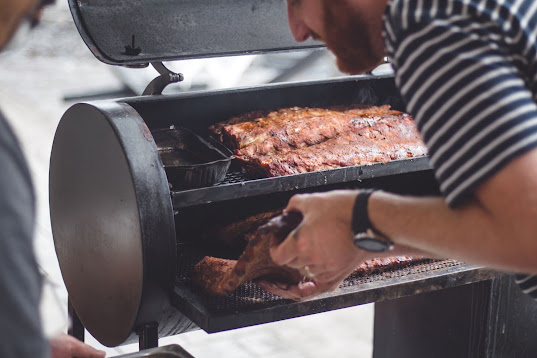The Food Lover's Guide to Summer Grilling
IT'S SUMMERTIME and the living is particularly simple, on the grounds that the peaches are ready, the watermelon is succulent and the steaks are singed and smoky. The sound of ice clunking in highball glasses rings through the roads. Out on the patio, new lemonade's being poured. Somebody's gathering sweet sungold tomatoes. The neighbors are smoking a brisket, and across the road they're flame broiling burgers and canines. Some place, a refrigerator has quite recently lost its last jug of brew. Furthermore, nobody misses the frozen yogurt man, since we've prepared a bunch of gelato at home.
 |
| Image source from 30seconds |
The regarded nineteenth century French culinary specialist Marie-Antoine Carême once expressed, "Meat is the spirit of cooking." Were Carême alive today and living in America, it's very likely he may change that assertion to, "Hamburger is the spirit of 'signaling." There might be no greater image for our nation's early stage, practically energetic, fixation on flame broiling than the cheeseburger or the steak. However, while burgers and New York strips or rib eyes are fast and simple to toss onto the 'prompt, isn't the spirit of flame broiling (or, rather, grilling) truly about standing inactively around the fire, refreshment close by, and chatting casually?
Barbecuing Beef
For the triplet's basic dish of dry-matured, bone-in prime rib with a barbecued vegetable plate of mixed greens, it's ideal to liberally salt and pepper the meat in any event daily in advance. "In the event that you salt it just before you flame broil it," says Owens, "you're simply preparing the outside."
Intuition may advise us to keep the meat fixed firmly in the cooler while it sits, yet Dyer says it's truly critical to allow the meat to sit in your refrigerator opened up. "Air is useful for meat," Dyer stresses. "It's essential for the maturing cycle."
And keeping in mind that each of the three meat aces concur that you ought to consistently haul the steak out one-half hour to an hour prior to you will flame broil it, their feelings vary with regards to knowing when the meat is finished. Owens puts stock in utilizing the natural "feel strategy"— contacting the meat with your thumb or index finger all through the cooking cycle to find out its extraordinariness—yet with regards to thicker cuts of meat, Dyer and Gorham are firm adherents to the meat thermometer. "The most costly thing you're truly going to cook is your protein," says Gorham, "and you would prefer not to screw it up."Grilling Chicken
Let's be honest: Very not many of us haven't at some time needed to persevere through a grill that comprised of just a heap of scorched, dried-out chicken bosoms and burnt drumsticks. A few of us are likely even blameworthy of facilitating a particularly embarrassment as a picnic ourselves, which brings up two issues: Why do most of terrace grillers accept that chicken preferences best when covered with the weighty residue of pyromaniacal ignition? What's more, for what reason do they believe that such darkened hunks of bird don't need side dishes with which to wash them down?
Barbecuing Chicken
Dolich likewise demands that individuals underseason their poultry. Much of the time, that puddle of grill sauce on your plate is only there to conceal the way that the chicken suffocating under it never had a shot at animating your taste buds in any case.
Dolich's answer for these errors is to douse the chicken (either entire or in parts) in a straightforward brackish water for as long as two days prior to cooking it. The salt-and-sugar arrangement helps keep the meat delicate and soggy while it's cooking, and the expansion of spices and flavors injects the bird with more muddled flavors. After the poultry has been appropriately salted, as it were, protuberance your hot coals aside of the grill, place the bird on water-splashed cedar boards over the cooler side of the barbecue and close the cover. By cooking the bird on the boards, you'll keep direct blazes or high warmth from singing your dinner, and in close to an hour or so your bird will be brilliant and fresh outwardly and succulent and delicate inside, with a sweet, pungent and smoky completion that endures deep down. And keeping in mind that Dolich's starter of flame broiled mussels and mollusks and his side dish of bread and tomato salad are welcome backups, you'll see that this specific barbecued bird—rather than the typical seared assortment—really can remain solitary.
Barbecuing Seafood
The jury may in any case be out on an authority meaning of Pacific Northwest food, however most culinary experts in Oregon and Washington concur that barbecued fish and shellfish have been a foundation of our district's gastronomy for quite a long time. Conventional Native American cedar-planked salmon is positively the Northwest's most well known barbecued fish dish of fare, yet with simple admittance to manila mollusks, Olympia shellfish, Dungeness crab and many types of fish savaged from Pacific waters, we've no shortage of other new, briny fixings to toss onto the shoot.
Flame broiling Seafood
Maybe the most straightforward assortment of fish to barbecue is shellfish, including clams and mollusks, both called for in Bechard's plans. When the warmth of your coals has died down to an even, medium temperature, it should just require a couple of moments for the shellfish to open up, and their defensive shells keep the delightful internal meat from consuming.
Barbecuing fish, then again, can be interesting. Regardless of what sort of fish you're flame broiling, Bechard says you ought to consistently brush your barbecue with oil that has a high smoking point—Bechard likes to utilize grapeseed oil or a mix of canola oil (75%) and olive oil (25%). Cooking times for every assortment of fish can shift extraordinarily—you ought to consistently ask your fishmonger for proposals—however relying upon the warmth of the flame broil, Bechard says that "per inch, you're taking a gander at around three minutes on each side."
Barbecuing Vegetables
Throughout the mid year barbecuing months, veggie lovers frequently get the crude part of the bargain. At lawn grills, they're compelled to remain alive on flavorless flaxseed-and-grain burgers alone, while carnivores devour elaborate multicourse menus of thick, succulent prime ribs and fire-barbecued clams. In the current month's soul of popular government and opportunity, we'd prefer to propose that all herbivores and carnivores be dealt with similarly.


Comments
Post a Comment